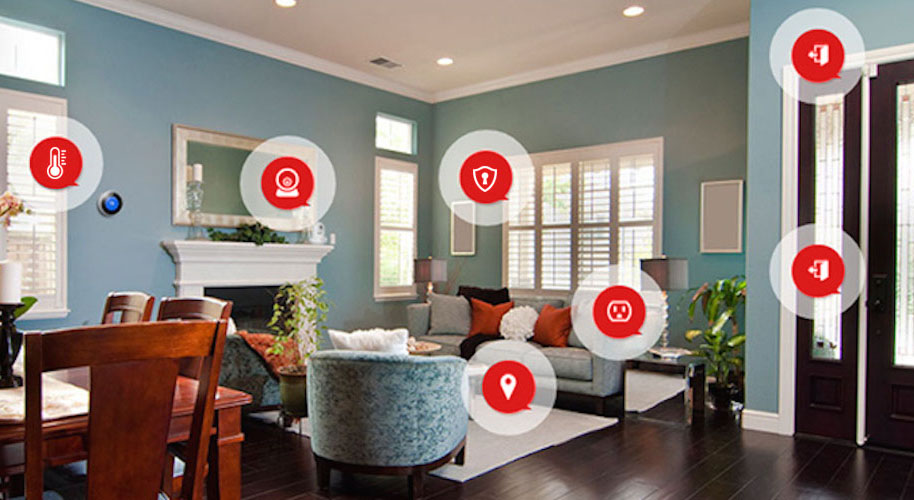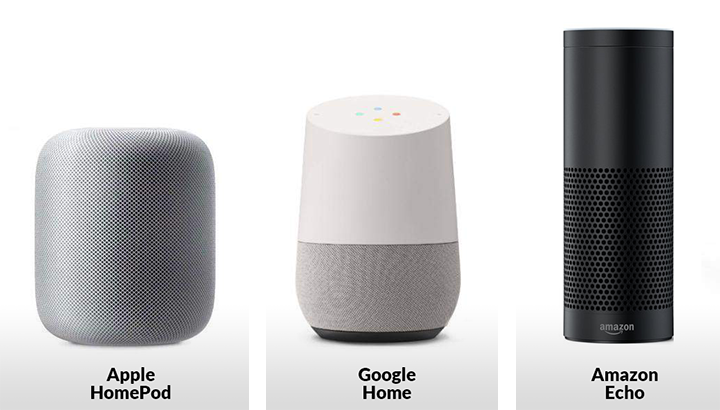Smart Home 101
Smart Home Basics from the Smart Home Experts, P.C. Richard & Son.
Make any home a Smart Home with Newsday Brand360 and P.C. Richard & Son
You’re driving home on a cold winter night. As you pull into the driveway, the garage door opens and outdoor security lights come on automatically. With one tap, your keyless front door unlocks, the interior lights come up and the window shades come down. Inside, the house is warm, the heating system activated remotely from your car. You say aloud, “Activate security,” and see the front door deadbolt latch, hear the garage door close and watch the backyard lights come on. Another word from you and music begins to play through hidden speakers. In the kitchen, one touch on the refrigerator door shows you what’s inside and displays recipes for dinner. After dinner and streaming your favorite show, errant crumbs are taken care of by your robotic voice-enabled vacuum. As you get ready for bed in the mattress programmed for your comfort, you relax, knowing that you—and your Smart Home—have everything under control.
What sounds like science fiction is reality in 2018, if you like 32 percent of U.S. homeowners have a Smart Home. “Smart Home” is the term commonly used to define a residence that has appliances, lighting, heating/cooling, consumer electronics, and/or security systems that are capable of communicating with one another and can be controlled remotely by a smart phone/tablet or voice assistant. Just as personal computing did in the 1980s, Smart Home technology is revolutionizing the way we live today. A sizeable and growing number of inexpensive, easy-to-use products are providing convenience, security, energy efficiency and other benefits to home owners. And, Long Islanders are realizing that smart devices are easier to install and more cost-effective than other home upgrades.
Source: Parks Associates IoT Market Research
Smart Home 101 – How it all began
Although Smart Home technology feels futuristic, it actually began decades ago as product manufacturers and “early adopters” in the homebuilding industry created amazing “do-it-for-you” home control features. Motion-detecting outdoor security lights were among the first of these devices, along with remote-control garage door openers and electronic push-button door locks. As this smart-product movement developed over the years, the cost of the individual devices has come down and the variety of products with built-in control features has expanded. But it’s recent developments in smart phones and voice control that have put whole-house control within reach of every home owner.
Get smart about Smart Homes

You don’t need to spend a small fortune, or require a degree in electrical engineering, to create your own Smart Home. Dozens of affordable, off-the-shelf, “plug and play” products can be easily linked through smartphone apps or home-based “hubs”, which are hardware or software that coordinates and controls the Smart Home devices for you. Hubs have moved from Smartphone-based to hands-free with the introduction of voice-control products, such as Amazon’s Echo, Google Home and Apple’s HomePod. You’ve probably heard a lot about smart speakers since their adoption has grown by double digits in the last two years, and they were the #1 holiday gift in 2017. Today, an estimated 47 million consumers have access to at least one smart speaker, and there will be more than 200 million smart speakers in use by 2020!
Sources: Amazon 2018 Press Release, voicebot.ai, Canalys
Smart Home starters
P.C. Richard & Son, Long Island’s largest electronics and appliance retailer for over 100 years, is helping to educate consumers about the benefits of Smart Home technology throughout the New York area. Their “hub” is a dedicated in-store and digital area, staffed by knowledgeable Smart Home experts that are dedicated to helping their customers plan, purchase and install devices to make any home a Smart Home.
Given all of the Smart Home products available today, the experts are P.C. Richard & Son offer the following simple steps to Smart Home success:
Choose a hub

A Smart Home hub connects various devices, and gives you control over each one via an app, voice assistant or screen-based system. So, a great place to start is with a voice-controlled Smart Home speaker that can serve as your home’s command center. Each smart speaker comes with a set of software and hardware that determines its functionality and compatibility. The software (also known as the voice assistant) controls Smart Home products through simple voice activated commands. The three biggest virtual voice-controlled assistants are Apple’s Siri, Google’s Assistant and Amazon’s Alexa. The corresponding hardware that works with each are: iPhones, iPads, HomePod and Apple Watch; Google Home and Android Smartphones; and Echo, Echo Dot and Echo Show, respectively. Other manufacturers are jumping into the control hub game as well. Regardless of which hub you choose, each allows you to control a growing list of compatible networked products like security, lighting and appliances through your home’s Wi-Fi router.
Set up lighting and temperature controls

The next thing to consider is lighting. Smart bulbs, like the Philips Hue, are easy to use and easy to set up. This lighting can be controlled directly through your smart speaker or smart phone and helps save energy and add security for your home. All bulbs have dimmers and some create mood lighting with changing colors. Just replace your existing bulbs with Smart bulbs, make sure your bulb is compatible with your voice assistant (Philips Hue, for instance, is compatible with Alexa, Google Assistant and Siri) and you’re ready to go.
Another Smart Home “must,” especially for Long Island homeowners, is control of your heat and air conditioning. A smart thermostat offers precise management of your home heating and cooling, making your life more comfortable and convenient, and at the same time saving energy and money. Smart thermostats, like Nest and Honeywell, connect to the internet via Wi-Fi so they can be controlled with a smartphone or virtual assistant. An adaptive Nest Thermostat “learns” your preferred heating and cooling comfort levels and adjusts itself to suit.
Plug and play with smart plugs and outlets

An inexpensive way to bring Smart Home technology into your home is by converting your existing electrical outlets with smart plugs. A smart plug is an adapter that turns simple appliances, like fans and coffee makers, into smart appliances with simple on/off functionality. Belkin has a line of plugs and dimmers under the Wemo brand that lets you wirelessly operate ordinary plug-in devices anywhere from your phone, tablet or laptop.
Secure your perimeter

For many of us, the biggest benefit of home automation is increased security and safety. Some of the products under this category include smart doorbells, cameras, locks, smoke and carbon monoxide detectors and sensors. For outside security Ring Video Doorbells and outdoor Ring Security Cameras include motion sensors and the ability to stream live video, so whether you are home or away you can see who is at your door before you open it. Remote keyless locks combine safety and convenience and, according to local real estate experts, can even increase your home’s value. Smart locks, like Yale Keyless Locks and Nest Hello, communicate with other home security systems and provide entry access using a phone app, digital keypad and even the sound of your voice.
When thinking about your home’s outdoor security, don’t overlook the garage. An estimated 71% of homeowners use the garage as their main access to their home, so maintaining control over that area is important for personal and property safety. Smart garage door controllers, like Chamberlain MyQ, work with your existing garage-door opener, letting you control the door from anywhere you are through an app on your smartphone or tablet.
Source: DASMA
Home safe home

Security inside your home is equally as important as outside. Now you can program your house to alert you to any danger through a variety of sensors and cameras.
Unlike traditional monitors, Internet-connected smoke and carbon monoxide detectors can send notifications to your phone with detected activity or, for battery-powered versions, alert you to low battery levels. Some, like Nest Protect, can even contact a neighbor or emergency contact when you’re out of town.
For both indoor and outdoor monitoring, you might want to consider the Nest Cam. Inside, this innocuous tabletop camera looks after your home and family with 24/7 live streaming and eyes and ears alert options. Think of this indoor camera as part baby cam, part pet cam and part security guard.
Together, these easy-to-install smart devices give you smartphone access to your home at any time — and peace of mind in the process.
Are you ready to get smart?
The list goes on, with a seemingly endless supply of new convenience gadgets being introduced every day. Each of these products can operate independently, but having the ability to link together and coordinate everything under your roof is what turns smart products into a Smart Home. Stop by your local P.C. Richard & Son and get “smart” today.
Product Links
The news and editorial staff of Newsday had no role in the creation of this content
















